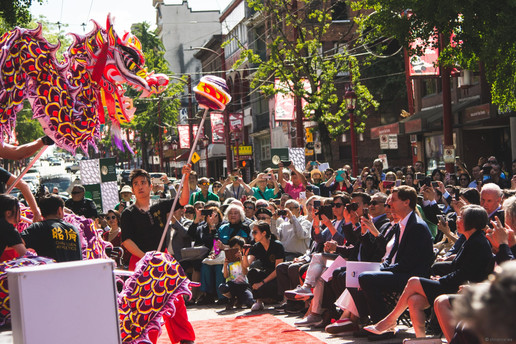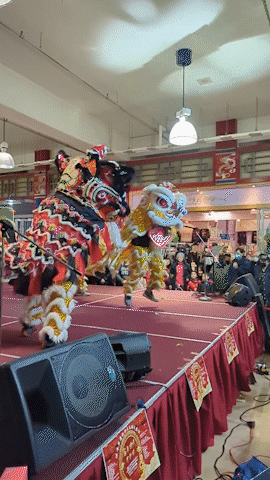What’s the Difference Between Dragon Dance and Lion Dance?
- Sifu Michael Tan
- Aug 23, 2024
- 7 min read
Updated: May 23
The main difference between dragon dance and lion dance is that a dragon dance has more people (usually nine people each holding a pole, making a snake-like puppet), while a lion dance has two people inside a lion costume. This consists of a papier-mâché head and a cape-like body draped over the dancer in the tail.
Dragon dances and lion dances are commonly mixed up. We get so many questions about our “dragon dances” when referring to lion dances that it’s almost reflexive for us to correct anyone who even starts to say the word “dragon”!
Because of this, we want to clear up any confusion and outline the differences between lions and dragons in Chinese performances. Here’s our comparison of the two types of dances:
Lion dance vs. dragon dance – side-by-side comparison
Here are some of the key differences when comparing lion dances and dragon dances:
Lion dance | Dragon dance | |
Number of performers (excluding percussion) | 2 people per lion costume | Usually 10, but varies depending on the size of the dragon |
Costume design | Big fluffy animal head and tail, with performers fully covered by the costume | Long puppet held high in the air with aluminum or bamboo poles. Performers are fully visible. |
Space required | Less (a dance floor for a wedding venue will do) | More (these are often performed in parades or wide, open areas) |
Moves | Acrobatic jumps and movements based off of kung fu | Long, sweeping movements with plenty of twisting and turning |
What is a dragon dance?
A dragon dance is a traditional Chinese dance performed by a large group of performers holding a long dragon puppet on poles.
The head of the dragon leads a team of eight other dancers (sometimes more or less, depending on the length of the dragon). These dancers follow one another to form a flowing motion.

The dragon will often chase a “Pearl of Wisdom”, which is spun around by a senior member of the club. The pearl represents wisdom and truth – it is said that this is what gives the dragon its power. During a performance, the pearl leads the dragon as it follows it with a line of dancers behind. The goal is to move the dragon as smoothly as possible and show the dragon actually dancing and weaving through the air.
Dragon dance performances can have a variety of different moves, mostly depending on the space the team has and time constraints. Some moves that you may see at a dragon dance include:
coiling and bowing towards the audience or other important landmarks,
making a sweeping 180° wave above the heads of the performers,
figure-eights and coordinated jumps,
having the performers “skip rope” with the lion, and
making custom poses, including aerial zig-zags, stacking, and making shapes like a maple leaf.
How many people are there in a dragon dance?
In the case of a common 18-meter long dragon, a dragon dance requires nine people. This is not including the person controlling the pearl, which brings the total to 10 people. It’s a big team effort.

In the case of a parade or other long or tiring event (which can exceed two hours), we have actually two teams that swap in and out for each other since it can get quite taxing. Changes are called on the fly like in hockey, with an entire lineup often being swapped one-for-one.
In addition to those 20 people, we also have a team of percussionists (usually one to two drummers and a revolving team of three to four cymbal and gong players).
When are dragon dances performed?
Dragon dances can be performed in parades or in large open events, often around Lunar New Year. The Chau Luen Athletics team perform at both, with highlights being our annual participation in Vancouver’s Chinatown Spring Festival Parade and our performances at the Chinese Canadian Museum and Canada Day.
Though dragon dances are mainly performed at community events like parades and major celebrations, we are open to performing at corporate events as well. As mentioned above, because of the large team required for a dragon dance, it’s best to book well in advance so we can round up enough people.
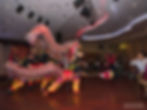
Dragons are a symbol of power, strength, and good fortune. Because of this, dragon dances symbolize bringing good luck to the community as a whole, and are often performed in front of huge crowds and major public events.
Origins of dragon dance
Dragon dances can be traced back to 206 BCE to 220 CE. The dance used to be performed in times of drought as a ritual to pray for rain and good weather as dragons were seen as creatures that had control over water. These rain dances have since evolved into an exciting form of entertainment.
The same sweeping moves that have entertained foreign dignitaries centuries ago are still used today in parades and other celebrations.
What is a lion dance?
A lion dance is a traditional Chinese dance where two people inside a decorated lion costume mimic a real-life lion’s moves to the beat of a drum. Lion dances are said to bring fortune and protection from evil spirits.
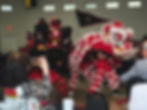
Two people perform in a lion costume and often, there are two lions performing together. The two most popular styles of lion dance are Hok San (鶴山) and Fut San (佛山). The style that we practice is Fut San, which has strong ties to traditional kung fu.
A typical lion dance routine will include things like:
the two lions bowing to each other,
exploring the space,
acrobatic jumps, sometimes onto poles or benches,
showering of lettuce for good luck, and
scroll presentation.
In terms of the lion dance roles, there are always two performers per lion and at least three percussionists.
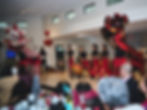
The head of the lion performs most of the visible moves and puppeteers the eyes, ears, and mouth. The performer in the back of the costume follows along and boosts the head performer up for acrobatic stunts when required.
All of this is led by a percussion team consisting of a drummer, a gong player, and some cymbalists.
When are lion dances performed?
Lion dances are typically performed at:
Lunar New Year and other holidays celebrated by Chinese people,
weddings,
milestone birthday celebrations,
baby showers
business openings, and
other public festivals (especially in places outside of China).
Lion dances are a way to bless things like businesses, newlywed couples, and to bring good fortune during the Lunar New Year.
Origins of lion dance
The origins can be traced back to an ancient legend. It is said that a king from Persia sent a pair of lions as a gift to the Emperor of China, which was mimicked by villagers to drive away a mythical beast.
Stories of this gesture of friendship from the Persian Empire, as well as the fearsome lion itself, spread far and wide across China. Tales of the lion’s giant fangs, its powerful claws, and its deafening roar became widespread and it became a symbol of power.
One day, a village was terrorized by a giant beast, which spread fear amongst the inhabitants and ate all of their food. Even though the villagers worked hard to replant and reharvest, the creature returned the next year and terrorized them again, leaving them short of food two years in a row.
The villagers, unsure what to do, went to a Buddhist monk to ask for advice.

The monk remembered the powerful lion with its quick-striking claws and ferocious demeanor, but knowing that the Emperor would never lend such a rare gift to some townsfolk, he suggested that the villagers make their own.
Everyone in the village teamed up to make a paper and bamboo lion, mimicking the giant teeth, vicious-looking eyes, and dyed it an aggressive, bright red.

When the next winter rolled around, the villagers were ready. When the beast came out of the forest, two athletic villagers challenged it head-on. They shook the lion head and gnashed its teeth. They jumped around acrobatically to mimic the agility that the real lion had. Because the paper lion couldn’t roar, other villagers banged on drums as loud as they could.

Their teamwork scared off the beast, and they lived on in peace.
This tale was passed down, and to celebrate, lion dancing was done not only to drive evil spirits away, but also has evolved into a beautiful artform and test of physical ability.
Modern-day lion dances
Today, lion dance can be seen as a performative piece, showcasing the skills of the best dancers in a kung fu club. As time evolved, modern influences have crept in as well. These include allowing women to participate in lion dances, lighter and more modern materials being used in the costumes, and the addition of LED lights and custom music when requested.

Lion dance FAQ
What do lion and dragon dances symbolize?
Lion dances are performed to bring blessings, whether to businesses, weddings, or for the new year. Dragon dances are performed to drive away evil spirits as well as bring good fortune to the community. As a whole, lion dance and dragon dance symbolize the bringing of good luck to all those in attendance.
Where do lion dance and dragon dance originate from?
Lion dance and dragon dance both originate from China but have spread all across the world where there is a large Chinese diaspora or places where Chinese culture has spread through colonization, such as Singapore and Malaysia.
Can women perform in lion dance?
In more progressive lion dance clubs, women are permitted to perform lion dances. However, some old-school clubs still do not allow women to participate in lion dance or relegate them to percussion or lion-wrangling roles. At Chau Luen Athletics, we proudly invite anyone, regardless of gender, race, or background, to learn and perform with us.

















